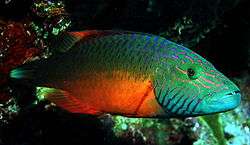Cheek-lined wrasse
| Cheek-lined wrasse | |
|---|---|
 | |
| Scientific classification | |
| Kingdom: | Animalia |
| Phylum: | Chordata |
| Class: | Actinopterygii |
| Order: | Perciformes |
| Family: | Labridae |
| Genus: | Oxycheilinus |
| Species: | O. digramma |
| Binomial name | |
| Oxycheilinus digramma (Lacépède, 1801) | |
| Synonyms | |
| |
The cheek-lined wrasse, Oxycheilinus digramma, is a species of wrasse native to the Indian Ocean and the western Pacific Ocean. It is of minor importance to local commercial fisheries and can also be found in the aquarium trade. The fish grows to about 40 cm (16 in) in standard length. The side of the fish's head has horizontal stripes, while the front of the head has red spots. Coloring of the fish varies from pale gray to purple. Aquarium specimens are less tense than their wild counterparts.[2]
Oxycheilinus digramma lives in coral reefs, sheltered inland areas, and lagoons, possibly at depths from 3 to 60 m (9.8 to 196.9 ft).[3] Juveniles of O. digramma have been observed to live among the tentacles of the mushroom coral Heliofungia actiniformis.[4] This species eats sea urchins, molluscs, and crustaceans. It uses other fish as a moving blind to approach its prey.[2]
References
- ↑ Liu, M. & To, A. 2010. Oxycheilinus digramma. In: IUCN 2013. IUCN Red List of Threatened Species. Version 2013.1. <www.iucnredlist.org>. Downloaded on 14 November 2013.
- 1 2 Michael, Scott (March 2004). "Aquarium Fish: The Cheeklined Maori Wrasse, Cheilinus diagrammus". Advanced Aquarist. Retrieved 6 August 2011.
- ↑ Froese, Rainer and Pauly, Daniel, eds. (2013). "Oxycheilinus digramma" in FishBase. August 2013 version.
- ↑ Bos, A.R. & B.W. Hoeksema (2015). "Cryptobenthic fishes and co-inhabiting shrimps associated with the mushroom coral Heliofungia actiniformis (Fungiidae) in the Davao Gulf, Philippines". Environmental Biology of Fishes 98 (6): 1479–1489. doi:10.1007/s10641-014-0374-0.
